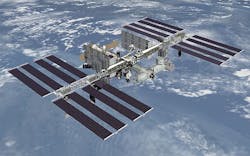NASA offers to partner with industry to develop advanced fuel cell technology for space
Officials of the NASA Johnson Space Center (JSC) in Houston this week issued a sources-sought notice (NNJ14ZBH025L) for the Hydrogen And Hydrocarbon Air Independent Fuel Cells project to accelerate technology development and strengthen commercialization of hydrogen and hydrocarbon air-independent fuel cells.
Related: Navy to field-test hydrogen fuel cell- and solar-powered military renewable energy system
NASA JSC has a long history of developing fuel cell systems using pure oxygen as the oxidant and pure hydrogen as the fuel. Such a system was the primary power source for the space shuttle orbiter, NASA officials point out.
Along with spacecraft applications, enhanced fuel cell technology could enhance the capability of unmanned underwater vehicles (UUVs) that must independent of surface power sources.
Related: Insitu ScanEagle UAV completes hydrogen-powered fuel cell flight test
Fuel cells convert the chemical energy from a fuel into electricity through a chemical reaction with oxygen or another oxidizing agent. Hydrogen is the most common fuel, but hydrocarbons such as natural gas and alcohols like methanol are sometimes used.
NASA officials particularly are interested in advanced fuel cells for future spacecraft power, and want to push this technology in three directions: higher reliability; higher-temperature heat rejection; and efficient use of fuel from reformed hydrocarbons.
Related: Navy to power unmanned underwater vehicles with fuel cell stack technology from Delphi
Potential solutions for the first requirement include dead-headed fuel cells of any chemistry, which have no active components for reactant management in the balance-of-plant. Potential solutions for the other two requirements center on solid oxide fuel cell chemistries, which can operate above 800 degrees Celsius, which can minimize the mass of heat rejection radiators, and can use carbon monoxide and hydrogen as fuel.
NASA partners on the fuel cell project may own the intellectual property together with NASA on technologies jointly developed. JSC has been working in collaboration with the US Navy to conduct testing programs and understand the system integration issues of potential fuel cell solutions.
Related: Navy demonstrates ability to launch surveillance UAVs stealthily from submerged submarines
Companies interested should email statements of interest forms no later than 11 April 2014 to NASA's Mark Dillard at [email protected]. Statement of interest forms, in Microsoft Word format, are available online at http://prod.nais.nasa.gov/eps/eps_data/159203-OTHER-001-001.docx.
For questions or concerns contact NASA's Mark Dillard by phone at 281-244-8460 or by email at [email protected], or Dana Altmon-Cary by phone at 281-483-8228 or by email at [email protected].
More information is online at https://www.fbo.gov/spg/NASA/JSC/OPDC20220/NNJ14ZBH025L/listing.html.
